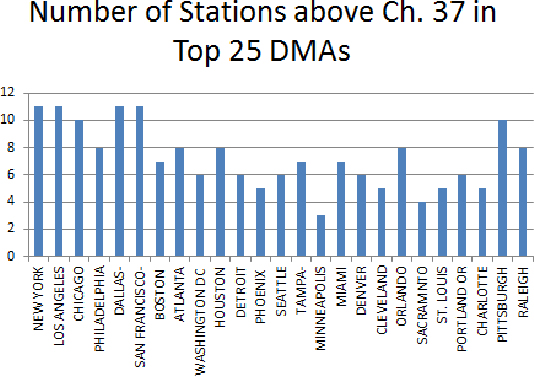NAB sets record straight on number of stations above 37
A study from computer chip maker Intel of spectrum use of channels 38-51 filed with the Federal Communications Commission in March miscalculates how many stations actually are assigned to channels above 37 in many markets, NAB said in comments filed with the FCC last week.
Wireless phone provider T-Mobile also cites the flawed Intel study in comments it filed with the commission, NAB said.
In a letter dated June 20 to the FCC, NAB said it wanted “to rectify immediately a significant and unfortunate error” in the Intel study that “inadvertently distorts the breadth of the challenge of repacking broadcasters as part of the auction process.”

Not only does the error minimize the scope of the problem, but also it “demonstrates how little is commonly understood about the task of relocating broadcasters who do not participate in the auction,” the letter, signed by Rick Kaplan, NAB executive VP, strategic planning, said.
According to Kaplan, the Intel study suggests that channels above 37 are not used in a large number of markets. The flaw in the Intel study appears to center on how the company identifies a TV market. Kaplan explained Intel’s study “mistakenly assumed that each station’s ‘city of license’ (i.e., the exact city to which the license is designated) is its relevant market” rather than using Nielsen’s Designated Market Areas (DMAs), which the agency has used to define TV markets for more than 15 years.
The problem with the Intel study is that “the city of license offers no analytical value whatsoever of the task of evaluating the prospect of repacking broadcasters,” the letter said.
As a consequence, the Intel study generates “nonsensical results,” such as assuming a station licensed to Tampa, FL, is in a different market from another station licensed to Tampa-St. Petersburg, FL, the letter explained.
“Perhaps the most egregious error resulting from this approach is that the study considers Florida stations licensed to Leesburg and Melbourne to be in different markets despite the fact that the stations are located at the same transmitter site,” it said.
The study’s flawed assumption about the city of license also led to the conclusion that Anchorage, AK, is the most congested TV market in the nation with seven stations using channels above 37.
A more appropriate approach is to look at repacking “through a DMA lens,” the letter said. From the DMA point of view, more than one-third of all full-power and Class A TV stations (602) in the UHF band are above channel 37, the letter said. About half of all DMAs have three or more stations assigned to channels above 37, and in the top five markets, 51 stations use channels above 37, with the number of stations on channels higher than 37 in each market varying between eight and 11 channels, the letter said.
“In the top 10 DMAs, there are 91 stations above channel 37 with six to 11 such stations in a market,” the letter said. In the top 25 DMAs, about 12 percent of the 210 TV markets, each market have three or more stations on channels above 37, it said.
The professional video industry's #1 source for news, trends and product and tech information. Sign up below.
“The purpose of correcting the record here is to suggest nothing more than that industry and the commission need to work from the same page to properly analyze and address the enormous challenge of repacking and relocating broadcasters,” the letter said.
